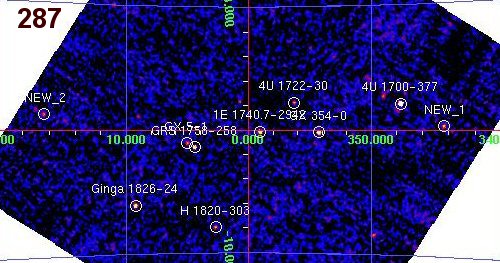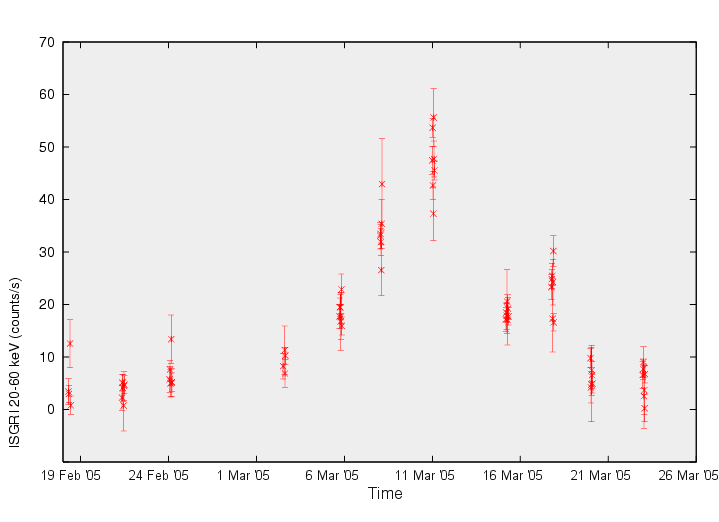GRO J1655-40 INTEGRAL Galactic Bulge Monitoring. Last Update: 23 March 2005 23:05


Picture of the MonthApril 2005GRO J1655-40 INTEGRAL Galactic Bulge Monitoring. Last Update: 23 March 2005 23:05 
287
288
289
291
292
293
294
295
296
297
298
The hard X-ray outburst of GRO J1655-40 as followed by the INTEGRAL Galactic Bulge monitoring programThe region around our Galactic center, the Galactic bulge, is rich in bright and variable high-energy X-ray and gamma-ray sources. From the start of the guest observer program AO-3, February 17, 2005, a program is in place (PI: Kuulkers) to observe this region regularly, using the European gamma-ray satellite INTEGRAL. One complete hexagonal dither pattern (7 pointings of 1800 sec each) is performed during each INTEGRAL revolution (i.e., every 3 days) whenever the region is observable. As a service to the scientific community, the IBIS/ISGRI and JEM-X light curves in two energy bands (20-60 keV, 60-150 keV and 3-10 keV, 10-25 keV, respectively) of the sources detected in the field of view, as well as IBIS/ISGRI mosaic images, are made publicly available as soon as possible after the observations are performed. The results, as well as more information about the program, can be retrieved from http://isdc.unige.ch/Science/BULGE/. This program was announced to the world in ATel #438. Precisely at the start of this program the black-hole X-ray transient GRO J1655-40 was reported to become active (see ATel #414). The light curve shown here is derived from the IBIS/ISGRI 20-60 keV band 1800 sec exposures obtained up to now (about 150 counts/s corresponds to 1 Crab on-axis). It shows the evolution over the last couple of weeks and demonstrates the wealth of the monitoring program. Note that it nicely complements observations at soft X-ray (RXTE) and radio (VLA) wavelengths. Indicated are also the INTEGRAL revolution numbers to which each cluster of data points corresponds to. When pointing with the mouse over each time span of observations, the mean 20-60 keV mosaiced image appears corresponding to each complete dither observation, which shows the detection significances on a square root colour scale. The brightest sources are annotated. Clearly, most of the sources vary on timescales down to a few days. Note that GRO J1655-40 was observed at a large off-axis angle (~15 degrees from the center of the field of view; so is in the partially coded field of view of IBIS/ISGRI and not visible with X-ray monitor JEM-X). Credits: M. Homminga (ESA/ESAC), E. Kuulkers (PI; ESA/ESAC), S. Shaw (Southampton/UK & ISDC/Geneva), and the rest of the Galactic Bulge monitoring team.
A service of ESA/ISOC |